
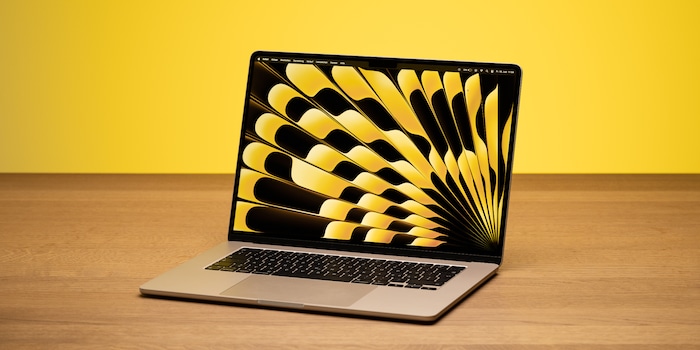
15-inch MacBook Air review: perfect balance
Apple’s lightweight laptop is now available with a larger display. The additional workspace makes the 15-inch MacBook Air an excellent all-round device.
Every laptop design struggles to balance compactness with screen size and endurance, while prices often increase in line with performance and build quality. The new 15-inch MacBook Air has the best combination of these elements I’ve ever seen. I’m testing the basic version with 8 GB RAM and 256 GB SSD.

In a keynote at the World Wide Developers Conference lasting over two hours, Apple dedicated only four minutes to the new MacBook Air. No wonder: it looks unspectacular at first glance because it’s practically identical to the well-known 13-inch version. The only difference is that the display size has increased by 1.7 inches. Nevertheless, the big Air is likely to be Apple’s most important computer since the switch to M-chips – a device for the masses.
Design: slimline
I need to be able to easily pick up a MacBook Air by one corner and carry it around. Twelve years ago, I found this feeling of lightness revolutionary. Back then, the second generation of the 13-inch model was my first ever Mac. The new 15-inch MacBook Air passes this test, feeling much easier to handle than my 16-inch MacBook Pro. With an aluminium case that’s just 11.5 millimetres thick, its 1.5 kilogramme weight still seems surprisingly heavy at first. Like holding a gold coin. The finish on my test model is flawless. It’s in the colour Starlight – somewhere between gold and cream.
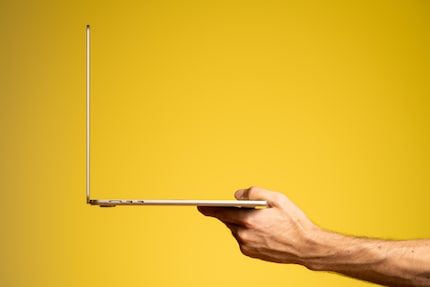
Source: Samuel Buchmann
Like all MacBooks, the Air has a notch at the top centre of the screen, which houses a 1080p webcam. The ports are limited to the essentials: MagSafe, headphone jack and two USB-Cs with support for Thunderbolt 3. I think that’s fine for this type of a laptop, although an additional Thunderbolt port on the right-hand side would be useful. Another downside: the Air only supports one external monitor.
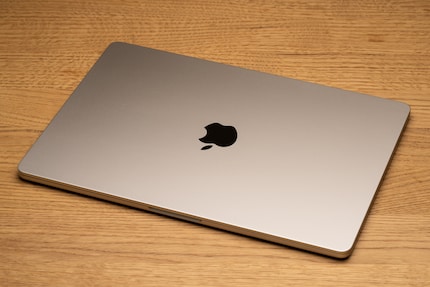
Source: Samuel Buchmann
Display: finally, more workspace
Technically, the screen is a slightly larger version of the display on the 13-inch model. It has a resolution of 2880 × 1864 pixels and a pixel density of 224 pixels per inch. The colour reproduction, contrast and sharpness are very good. The maximum brightness of 500 nits is more than sufficient indoors, but I’d like more outdoors.
How noticeable is the larger display in everyday life? 1.7 inches more on the diagonal doesn’t sound like much, but that means 26 per cent more workspace. For me, it completely transforms the MacBook Air. While the 13-inch model is primarily suitable for full-screen browsing and word processing programs, I can also open two windows side by side with the 15-inch version. In Lightroom, photos are much larger because the navigator and settings no longer take up as much of the workspace. In DaVinci Resolve, too, the player no longer looks like a postage stamp and I can work with it properly.
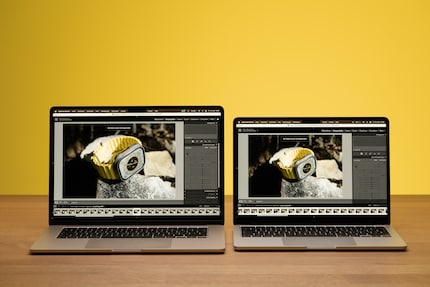
Source: Samuel Buchmann
In applications like these, the extra 1.7 inches make the difference in terms of whether I definitely need an external monitor or not. It’s a huge advantage for any minimalists on the go who want to get by with just a laptop.
Keyboard, touchpad and speakers: tried and tested
If you’ve held one of the latest MacBooks in your hands in the last two years, you’ll be familiar with the new Air’s keyboard. Typical for laptops, it’s flat and smooth. Whether you like that is down to personal taste. I like typing on it.
The touchpad is also excellent, as usual. It uses the entire surface between the edge of the case and the keyboard. So, Apple hasn’t simply copied the smaller model’s touchpad; it’s made a standalone version for the larger one.
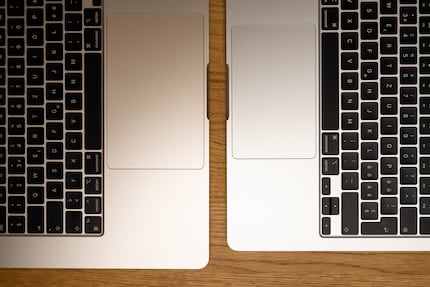
Source: Samuel Buchmann
The large Air has six speakers, two more than in the smaller version. That means it sounds a little better and very good for a laptop. The speakers are more than adequate for a Netflix series without headphones. However, they don’t come close to the excellent sound from the thicker 16-inch MacBook Pro.
Power: enough for almost everything
As the M2 chip isn’t new, there are no surprises when it comes to the performance of the 15-inch MacBook Air. A small difference compared to the 13-inch model: even the basic version comes with ten graphics cores, while the small Air only has eight. If you want ten, that costs extra – which considerably cuts the price difference between the sizes. The 10-core CPU is the same.
How much RAM you should have depends on what you’re using your laptop for. The basic version with 8 gigabytes (GB) is enough for office work. For image and video editing, I’d go for 16 GB. However, the maximum possible 24 GB seems OTT for the performance of the M2.
As with all models with an M2 chip, the basic SSD with 256 GB is slower than the larger versions. You notice this when you load the RAM and the SSD has to step in as a buffer. But the difference isn’t dramatic. You can find detailed benchmarks in my review of the M2 Mac Mini. These results can also be applied to the SSD of the MacBook Air:
Benchmarks: no surprises
My CPU benchmarks hardly show any differences compared to the 13-inch MacBook Air. At the same time, this means that, in single-core tests, the 15-inch MacBook Air is almost as fast as the 14-inch MacBook Pro with M2 Pro chip. As expected, the Pro performs better in multi-core benchmarks and achieves 70 per cent higher scores on average. The advantage is even greater in the graphics benchmarks – the Pro chip is an average of twice as fast as the 15-inch MacBook Air. The 8-core GPU of the 13-inch version is even further behind.
Productivity: the pro is out in front
You won’t notice any difference in the office load between the MacBook Air and MacBook Pro. This is shown, for example, by the browser benchmark Speedometer 2.0, where the Air is even slightly ahead.
Image and video editing is a different story: in Lightroom, the M2 chip takes almost twice as long as the M2 Pro to export 100 RAW images with 50-megapixel resolution. That’s not too bad, because the editing itself runs smoothly. So, the Air is fine for occasional image editing. Only things like the new AI noise reduction take a little longer.
Simple 4K projects can be edited smoothly in DaVinci Resolve. However, noise filters and effects bring the thin laptop to its knees. Exporting my test project takes almost three times as long as the M2 Pro MacBook Pro. Mind you, it consists of a mix of 4K and 8K videos in the processor-intensive H.265 codec. This load exceeds the limits of what I’d put the MacBook Air through. If you want to cut complex videos regularly, you need more power.
Temperatures and cooling: not for extreme situations
Silence is the prevailing sound in my room when I’m working on the MacBook Air. It doesn’t have a built-in fan; heat is only dissipated via the case. This design saves space and works well for light loads or short spikes. Apple’s efficient chip means the laptop barely gets warm with normal use. Perfect for the office.
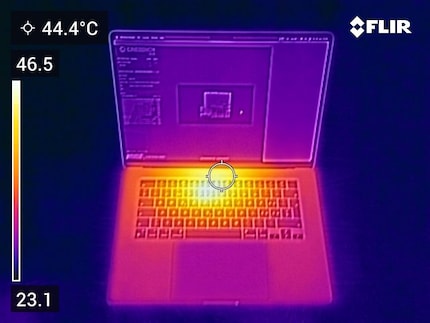
Source: Samuel Buchmann
The downside of the lack of fan becomes apparent in persistently computing-intensive applications – such as exporting a video project as mentioned above. First, the case gets warm – the FLIRCam measures up to 46.5 degrees Celsius. Secondly, the CPU has to clock down after just one minute of the Cinebench stress test because it reaches over 100 degrees. From 3.2 gigahertz, it slowly goes down to 2 gigahertz. A MacBook Pro with active cooling maintains maximum clock rate over a longer period of time. With typical use, however, a MacBook Air should rarely be in such situations.
Battery life: you can leave your charger at home
According to Apple, the 15-inch MacBook Air should deliver «battery for the whole day». It keeps that promise. The laptop lasted almost 17 hours in my YouTube endurance test, just like the 13-inch version. The 14-inch M2 Pro MacBook Pro manages a good 14 hours.
When you need to do a computationally-intensive task, the Pro has a slight advantage – it’s faster and uses about the same percentage of battery as the Air. After five exports of my test project in DaVinci Resolve, the 15-inch MacBook Air has 54 per cent left, the 14 Inch MacBook Pro 57 per cent.
Overall, these results are excellent given the display size and light weight. They mean you can easily leave the charger at home for a day’s work – except maybe if you’re constantly editing videos or compiling hours of code.
Verdict: it does everything right
The 15-inch MacBook Air is my new favourite laptop. It’s beautiful, thin and light. And it still has plenty of workspace, long battery life and is fast enough for almost anything. Apple has even been restrained when it comes to the price. This makes the new Air a perfectly balanced device for students and anyone who needs an office laptop.
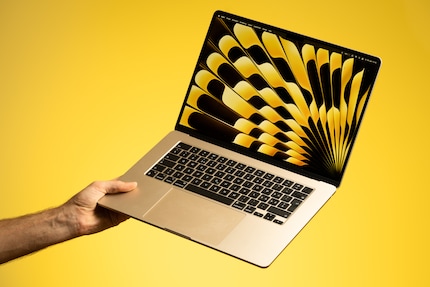
Source: Samuel Buchmann
The larger display compared to the previous 13-inch version also makes the Air attractive to new target groups. For example, amateur photographers who don’t want to fork out for the 16-inch Pro model. However, if you want to max out Lightroom and Photoshop, you’d be better off upgrading to 16 GB RAM and at least 512 GB SSD. The Air can even handle simple 4K video projects.
The slimline laptop only reaches its limits in extremely computationally-intensive scenarios. That’s where the Pro models with stronger chips offer added value. Or if you want to run multiple external screens. For everything else, I can wholeheartedly recommend the 15-inch MacBook Air. It does everything right.
Header image: Samuel Buchmann
My fingerprint often changes so drastically that my MacBook doesn't recognise it anymore. The reason? If I'm not clinging to a monitor or camera, I'm probably clinging to a rockface by the tips of my fingers.



